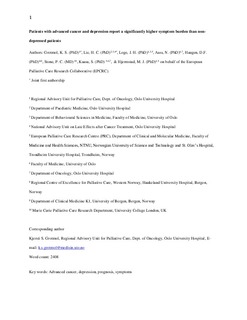| dc.description.abstract | Objective
Clinical observations indicate that patients with advanced cancer and depression report higher symptom burden than nondepressed patients. This is rarely examined empirically. Study aim was to investigate the association between self-reported depression disorder (DD) and symptoms in patients with advanced cancer controlled for prognostic factors.
Method
The sample included 935 patients, mean age 62, 52% males, from an international multicentre observational study (European Palliative Care Research Collaborative – Computerised Symptom Assessment and Classification of Pain, Depression and Physical Function). DD was assessed by the Patient Health Questionnaire-9 and scored with Diagnostic and Statistical Manual of Mental Disorder-5 algorithm for major depressive disorder, excluding somatic symptoms. Symptom burden was assessed by summing scores on somatic Edmonton Symptom Assessment Scale (ESAS) symptoms, excluding depression, anxiety, and well-being. Item-by-item scores and symptom burden of those with and without DD were compared using nonparametric Mann-Whitney U tests. The relative importance of sociodemographic, medical, and prognostic factors and DD in predicting symptom burden was assessed by hierarchical, multiple regression analyses.
Result
Patients with DD reported significantly higher scores on ESAS items and a twofold higher symptom burden compared with those without. Factors associated with higher symptom burden were as follows. Diagnosis: lung (β = 0.15, p < 0.001) or breast cancer (β = 0.08, p < 0.05); poorer prognosis: high C-reactive protein (β = 0.08, p < 0.05), lower Karnofsky Performance Status (β = −0.14, p < 0.001), and greater weight loss (β = −0.15, p < 0.001); taking opioids (β = 0.11, p < 0.01); and having DD (β = 0.23, p < 0.001). The full model explained 18% of the variance in symptom burden. DD explained 4.4% over and above that explained by all the other variables.
Significance of results
Depression in patients with advanced cancer is associated with higher symptom burden. These results encourage improved routines for identifying and treating those suffering from depression. | nb_NO |
